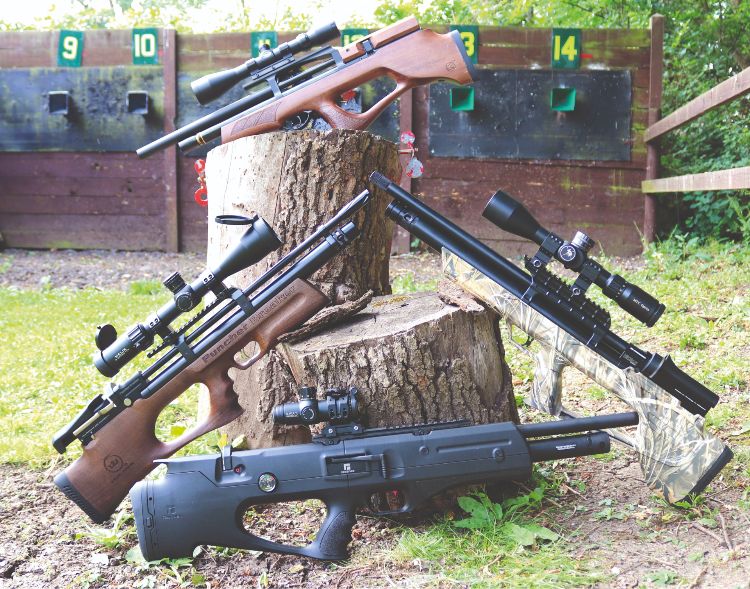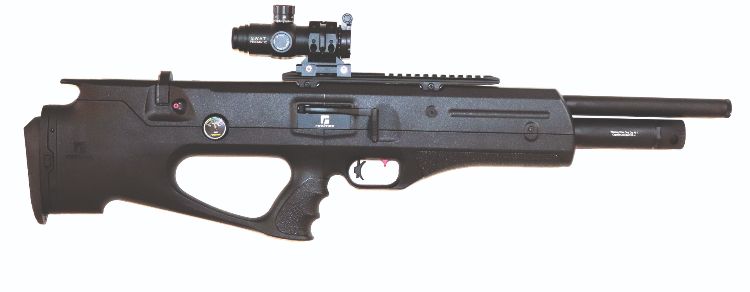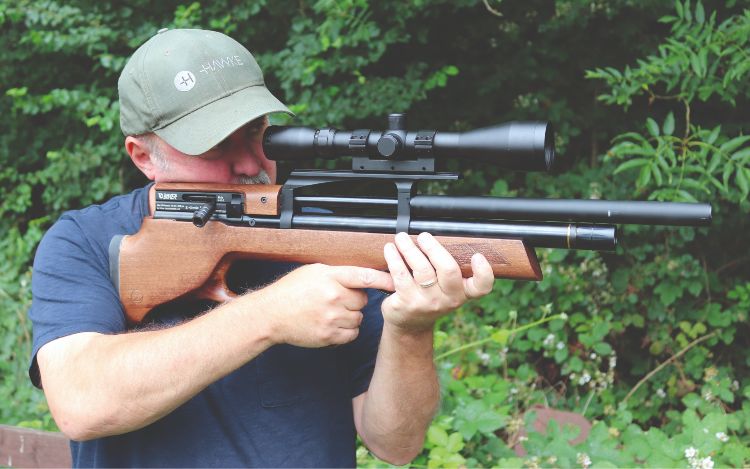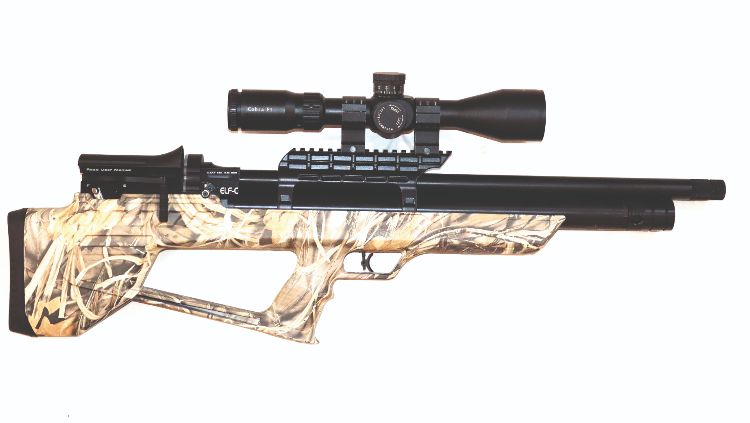Love them or loathe them, bullpups are here to stay. They are a relatively recent entrant to the airgun market and loosely defi ned as a rifle in which the trigger is located forward of the breech. It’s a configuration that has split opinion – a true Marmite rifle!
 Bullpup advocates point to the fact they are more compact, if not necessarily lighter, than conventional rifles, and more pointable, making them ideal for use in hides and vehicles. Detractors call them ugly with poor shoulder fit and a top-heavy nature that makes them unwieldy. Whichever side of the fence you sit, the choice for bullpups is getting bigger all the time and whilst some models run well into four figures, there are affordable options. We’ve brought together four for this test, all of which can be found for less than £600.
Bullpup advocates point to the fact they are more compact, if not necessarily lighter, than conventional rifles, and more pointable, making them ideal for use in hides and vehicles. Detractors call them ugly with poor shoulder fit and a top-heavy nature that makes them unwieldy. Whichever side of the fence you sit, the choice for bullpups is getting bigger all the time and whilst some models run well into four figures, there are affordable options. We’ve brought together four for this test, all of which can be found for less than £600.
KRAL PUNCHER BREAKER BULLPUP (see main image)
£475 RANGE-RIGHT.CO.UK
Kral led the way when it came to growth of Turkish rifles in the UK, and right at the front of the landing party was the Puncher Breaker Bullpup – a rifle that has undergone several refinements over the years. It’s very much a bullpup in the traditional style, with the cocking lever located right at the back of the action, but priced well below our £600 price point, it still warrants close consideration. Available in .177, .22 and .25 calibres at 12 ft.lbs., the range features walnut, black synthetic and camo stock options, and if you really want to stand out, the Marine editions have silvered metal work. The walnut model we have on review has a hefty chunk of good quality wood and features a sculpted fore end as well as contours for your fingers on the pistol grip. Although undeniably attractive, all that wood means the Breaker Bullpup tips the scales at nearly 4kgs unscoped, but at 760mm it’s very compact. A perforated rubber shoulder pad combined with the chunky fore end makes this a comfortable rifle to shoulder. Gold caps to the stock bolt located under the pistol grip and a thread to receive a Picatinny accessory rail that is provided are nice touches.
The stock may be ambidextrous, but the cheekpiece, which can be adjusted into three positions, favours right-handers and so does the silver-coloured side lever that is sprung for the first stage. Below it is a safety catch and forward is a power adjuster that works by choking the transfer port. With a pull length of 410mm, the post and shoe trigger would grace many more expensive rifles. The two stages are very defined and the let off is nice and clean. Further adjustment is possible by removing the stock. The scope rail provides a solid 190mm Picatinny platform, and because the 525mm barrel is not shrouded it has quite a bark. Fortunately, unscrewing the ornate muzzle protector reveals a ½-inch UNF thread to take a silencer. Thanks to the chunky stock, the 280cc air cylinder protrudes only slightly. Rotating an end collar reveals the fill port to receive a filler probe for a 200-bar fill. A manometer on the end of the cylinder indicates when you need to fill with air again. On the range, it was not pellet fussy and our .177 test rifle printed 5p size groups with JSB Exacts at 30 metres. Average output was a healthy 11.32 ft.lbs., with a variance of 24 feet per second over a full magazine.
 REXIMEX REGIME
REXIMEX REGIME
£499.99 JUSTAIRGUNS.CO.UK
Over the last decade or so, Turkish rifles have come to epitomise epithets such as ‘mid-range’ and ‘affordable’, but that’s not a back-handed way of saying they are cheap and shoddy. Far from it. The Reximex Regime is a perfect example and is capable of embarrassing many more expensive rivals. The synthetic – let’s call it plastic – ambidextrous stock may not be to everyone’s taste, but is excellent quality and as tough as old boots with no sense of flimsiness or hollowness. Taking up 630mm of the Regime’s overall 810mm length, it features panels of moulded stippling on the fore end and pistol grip, and a large cut-out to access the trigger. Pushing a button allows the rubber shoulder pad to be adjusted into one of fi ve lockable positions to fi ne-tune shoulder fit.
Halfway down the rifle, the sidelever features a large drop-down handle that operates smoothly in two stages. The presence of a blanking plate on the opposite side indicates the lever can be swapped over for lefties.
The cocking stroke also cycles a pellet through the 14-shot .177, or 12-shot .22 magazine, the design of which is seemingly ubiquitous to all Turkish rifl es. You get two, and to fill them you must first rotate a clear plastic faceplate almost 360 degrees clockwise. With the sidelever pulled back, the magazine is inserted into the breach, round end fi rst, from the right with a horizontal ridge aligned with a groove.
Forward of the breech is a power adjuster that can be altered with a small screwdriver, and thoughtfully enough, undoing the drop-down handle on the sidelever reveals a tool designed specifi cally for the purpose. At the other end, the 650mm shrouded barrel has no facility to accept a silencer, but the shroud is filled with baffl es and does a reasonable job of smothering muzzle crack.
Triggers have been considered a weak point on many bullpups because the trigger/breech layout relies on connecting rods that can introduce vagueness. However, the two-stage ‘post and shoe’ set-up on the Regime is excellent for a rifl e at this price point. The trigger guard also houses a resettable manual safety catch.
Mounting a scope is easy thanks to a 250mm-long Picatinny rail, which somewhat confusingly incorporates a bubble rail in the middle that would be diffi cult to see with a scope in place. Another on top of the butt is better placed, but will only indicate elevation and not whether you are canting the rifle.
Filling up the 310cc air cylinder to a maximum of 250 bar – although in all honesty, I preferred 200 bar – is achieved by inserting a provided probe into a port accessed by rotating a collar on the end.
On the range, I was able to squeeze out just over 100 shots from a 200-bar fi ll. Without a regulator, there was a power curve, but with a noticeable sweet spot of around 40 shots from around 190 to 150 bar averaging 10.55 ft.lbs. with a variance of 14 feet per second. In terms of accuracy, groups of 20mm or less at 30 metres were easily achieved.
 GAMO BOXER BULLPUP
GAMO BOXER BULLPUP
£609 GAMOGUNS.CO.UK
Gamo makes some fine affordable rifles, and its Boxer Bullpup does a lot more than simply tick a box in the product line up. Measuring only 743mm and weighing just over 3.5kgs, the Boxer Bullpup is compact and light enough. Thanks to the bullpup layout, the cold hammer-forged barrel is full length at 380mm. The shroud incorporates a series of baffles and takes the overall barrel length to 568mm. There’s no provision for a silencer, but removing the shroud reveals a thread on the barrel itself. You’d need a thin silencer to clear the air cylinder, and in any case, the shroud does a commendable job of reducing muzzle blast.
The ambidextrous beech stock is simple, but not unattractive. Forward of the sold rubber butt pad, the cut-out is generous and well-proportioned, giving good access to a pistol grip that swells nicely to the hand and has panels of stippling. The fore end gives plenty of room for your lead hand and is stippled, too.
Like all mechanical bullpups, the Boxer’s trigger relies on a rod to connect it to the let-off mechanism. As a result, the first stage felt a little vague and there was some creep on the second stage, but it broke cleanly and consistently, and after five minutes on the range I got used to it. Although the stock is ambidextrous, the wooden cheekpiece is set up for right-handers, as is the bolt-action cocking system. Don’t be tempted to overtighten the screws holding the cheekpiece – I found doing so pinched things up and hindered the cocking process. Forward of it, the 205mm raised dovetail rail gives plenty of room for a scope.
The bolt requires a firm hand and I had to put my thumb behind the action to pull back the large, knurled handle. The safety catch is located underneath – push it forward to shoot and back to be safe. The cocking process cycles pellets through a standard design mag’ that takes 10 shots in both .177 and .22 and features a handy count-down feature. As with other Gamo rifles, the Boxer Bullpup takes a 232-bar fill, which is achieved by pulling a plastic sleeve from the front of the cylinder and inserting the probe. The .177 test rifle returned around 80 shots of which half fell within a sweet spot with a variance of 18fps and an average output of 11.35 ft.lbs. No doubt due to the quality of the barrel. Unsurprisingly, 10.49 grain BSA Black Stars had an edge, delivering sub £1 coin groups at 30 metres.
 NIKSAN ELF C
NIKSAN ELF C
£424.99 JUSTAIRGUNS.CO.UK
Niksan is one of the more recent Turkish entrants to the market, yet its range of PCP rifl es is extensive. The Elf sub-range comprises three models; the C, presumably for camoufl age stock we have on test, the W (walnut) and S (synthetic). All three represent excellent value for money, not least because you get four magazines, a fore end grip-cum-bipod and a good quality hard case. Measuring just 780mm from the butt to the end of the 570mm barrel, which is finished with a ½ inch UNF thread to accept silencer, the Elf-C weighs a shade over 3.5kgs, and the ambidextrous synthetic stock is very solid and smooth to the touch. The woodland camo design is wellfi nished and the stock features a number of slots and cut-outs at the butt end, which is fi nished with a solid rubber pad.
A plastic cheek rest lacks any adjustment, but is both comfortable and provides good alignment for a scope mounted on the 75mm-long Picatinny rail. Although it cannot be swapped around, it will also serve left-handed shooters.
Although located right at the back of the action in true traditional bullpup style, the Elf-C can be cocked without coming off aim. Behind the sidelever is a large, manual and resettable safety catch – push it forward to make the rifl e safe and back to shoot. The magazine is a slight departure from the typical Turkish rifl e magazine and features a magnet on the underside. It takes 12 and 14 shots in .22 and .177 calibres respectively. Forward of the breech is a power slide which has no markings other than ‘+’ and ‘-’. On the range, the Elf-C generated 10.52 ft.lbs. on the maximum setting and a little over 8 ft.lbs. on minimum. A large cut-out gives good access to the pistol grip that has a couple of contours for your fingers. A couple of moulded panels give some grip, but there’s no stippling or chequering. The pull measures 380mm and the two-stage post and shoe trigger, although adjustable, felt a little notchy. That said, at 30 metres, I was able to return 20mm full magazine groups, time after time, throughout the 200 shots I managed from the 200 bar. Again, due to the Elf-C not being regulated, a power curve was evident with a range of 9.4 to 10.52 ft.lbs., or 710 to 751fps at the top and bottom of the fill. Consistency was good at just 12fps in the sweet spot.
GOOD THINGS, SMALL PACKAGES
Let’s be honest, some of us dismissed bullpups as a faddy flash in the pan, but how wrong we were! Today, just about every manufacturer has one and they fill a legitimate need for thousands of airgunners. Some simply like the aesthetics, and some just want something different. However, for many, bullpups serve a more practical requirement; thanks to their compact proportions but full-size barrels, they are ideal for shooting from hides, vehicles and other confi ned or cluttered spaces. Whatever your reason for wanting or needing a bullpup, choose wisely and you’ll fi nd one that will shoot just as well as any other rifle or carbine.